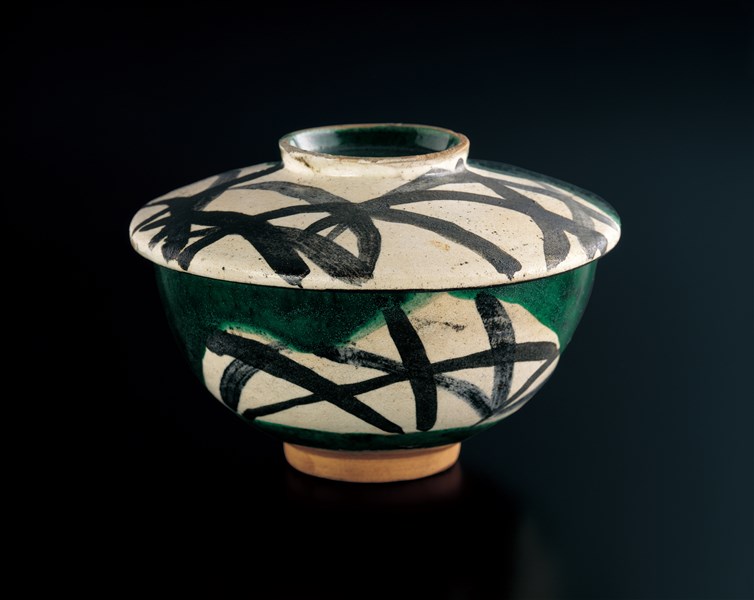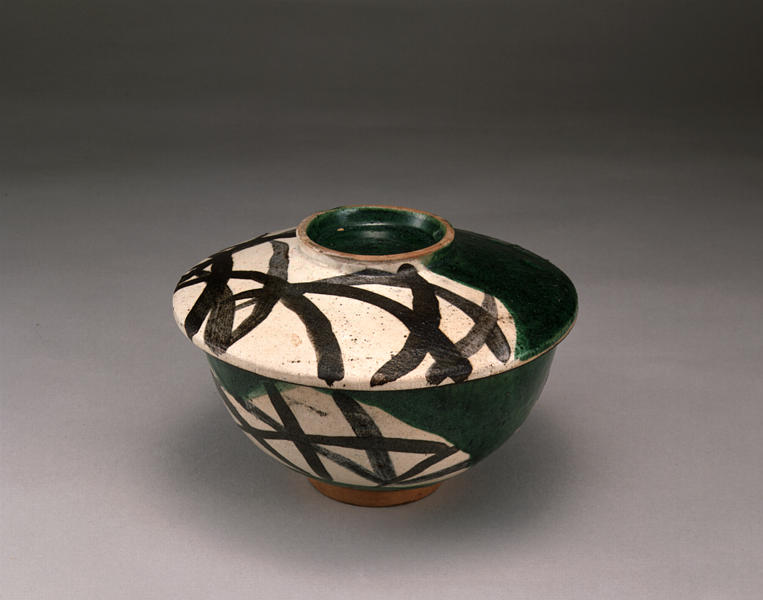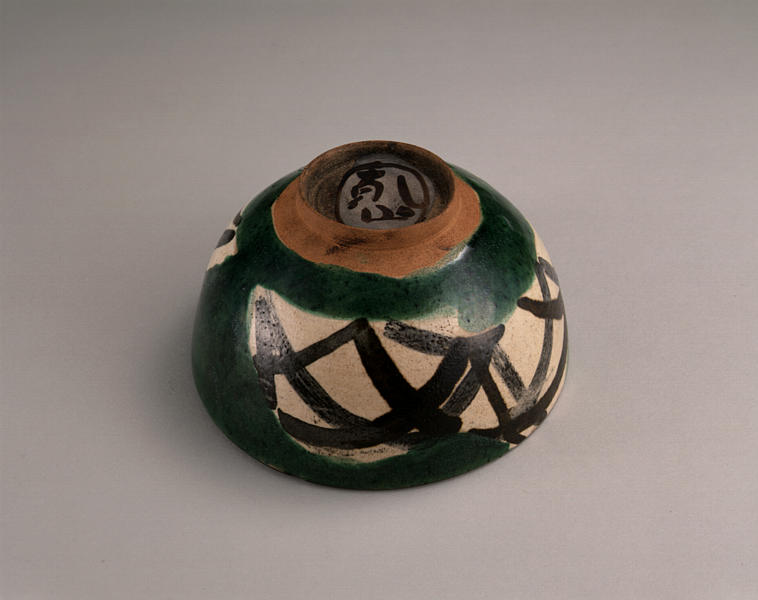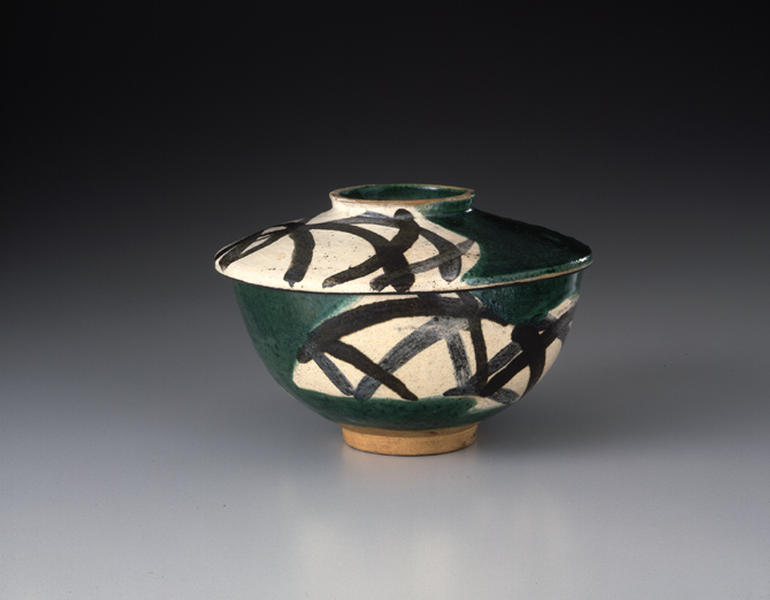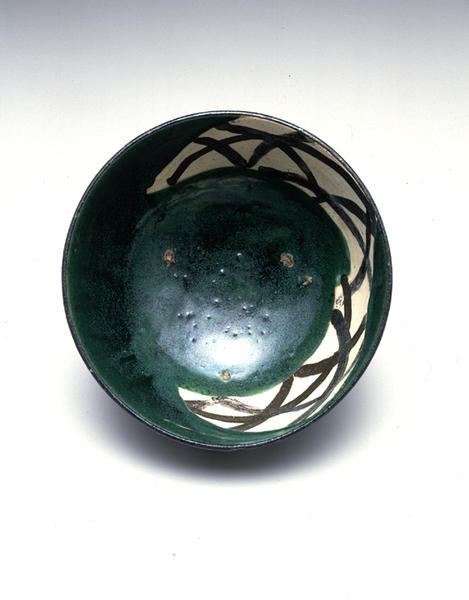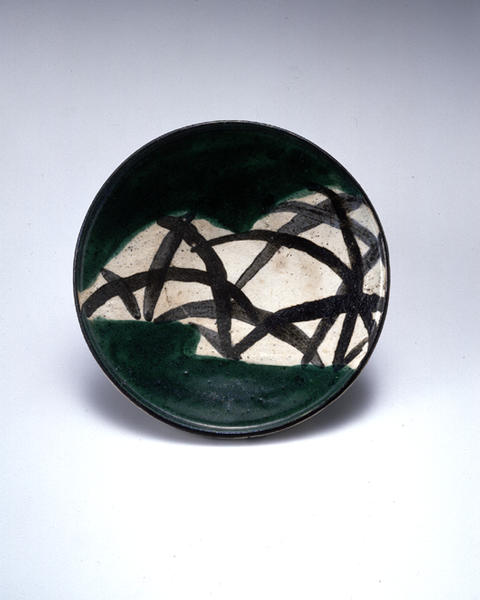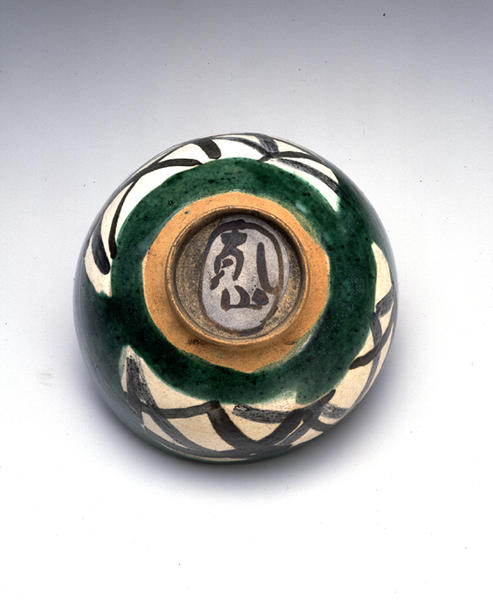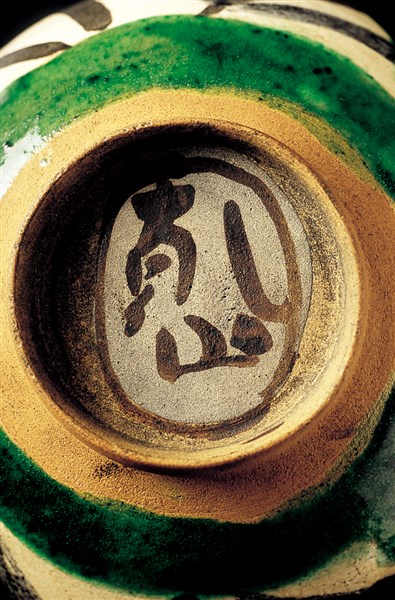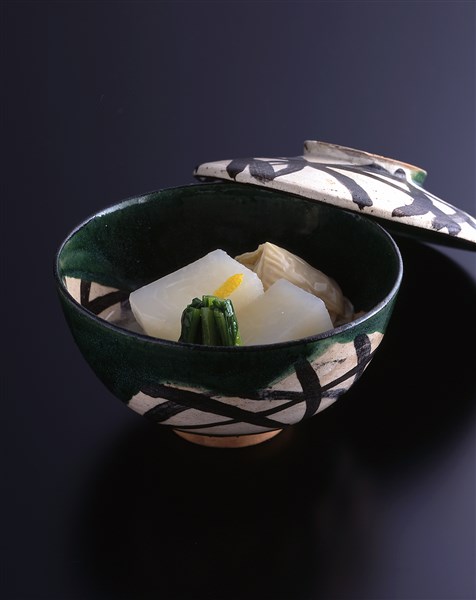乾山色絵薄図蓋茶碗
- 京都
- 江戸時代
- 18c
- 乾山陶
- H-9.5 D-14
乾山の作風はすこぶる多種多様である。銹絵、色絵、日本のものに限らず、朝鮮の刷毛目や中国の磁州窯、オランダのデルフト窯などの写しなど実に多彩である。豊かな教養と広範な知識を有していた乾山は、それぞれの特徴の吸収して巧みに自らの作品に反映
させていったのである。
この蓋付碗は薄く丁寧に轆轤成形された器胎に白化粧が施され、その上から鉄釉で薄を描き、無地の部分を緑釉で掛け分けている。そこには織部風の意匠が見てとれる。この無地と文様部分、色使いの明暗のコントラストはまさに織部があみ出した意匠であり、乾山はそのバランス感覚を見事に自分のものとしている。しかも薄の文様には、優美ではあるが線の細さを感じさせる京焼の作風は微塵もなく、宗達、光悦、光琳の流れをくむいわば琳派の意匠性が感じとれるのである。
身も蓋も全面に意匠が施されたこの茶碗は、もとは五客ないし十客の組物であったと想像されるが、一客のみが伝わっている。高台内には銹絵で楕円形に縁取られた白化粧の上に同じく銹絵で乾山銘が記されている。
尾形乾山
尾形乾山(おがたけんざん 1663~1743)
乾山は、寛文3年(1663)京都の富裕な呉服商尾形宗謙(おがたそうけん)の三男として生まれました。兄は画家の光琳です。二人の性格は対象的で、光琳が派手好みであったのに対し乾山は内省的、隠遁的な性格の持主であったといわれています。
野々村仁清に陶芸を学んだ乾山は、元禄12年(1699)37歳のとき京都市の鳴滝に開窯しました。そして正徳2年(1712)50歳の乾山は、京市内の二条丁子屋町に移住し、多くの作品を手がけ「乾山焼」として世にもてはやされました。鳴滝時代の末期からこの丁子屋町時代にかけて兄の光琳は絵付で乾山を助け、兄弟合作の作品が数多く残されています。
享保16年(1731)69歳の頃に江戸に下り寛永寺(かんえいじ)領入谷(いりや)に窯を築いて晩年を送りました。そして81歳で没するまで江戸に在住し陶器や絵画の制作に手腕を発揮しました。
乾山の作品は陶芸作品のみならず書や絵画においても、俗気を脱したおおらかで文人的な洒脱味があります。陶芸作品においては成形、施釉、焼成は他の専門的な陶工に任せたり、絵付についても光琳との合作以外に複数の専門画家が携わっていたと思われるなど、基本的には工房生産という態勢をとっていたようです。しかし、乾山の指導のもとにつくられたやきものには、その大胆なデザイン感覚とともに乾山特有の芸術性が溢れ、乾山その人とふれあうような親しみが感じられるのです。
乾山銹絵染付掻落絵替汁次
乾山銹絵染付梅波文蓋物
乾山立鶴図黒茶碗
乾山銹絵染付桔梗図筒向付
乾山銹絵染付草文四方鉢
乾山銹絵染付松図茶碗
乾山色絵短冊皿
乾山銹絵絵替長平皿
乾山色絵寿字輪花向付
乾山銹絵絵替四方皿
乾山銹絵染付絵替筒向付
乾山銹絵染付松図茶碗
乾山色絵椿文向付
乾山銹絵染付春草図茶碗
乾山銹絵染付藤図向付
乾山色絵立葵図向付
乾山色絵雪杉図向付
乾山色絵桔梗文盃台
乾山銹絵馬図香合
乾山銹絵染付絵替扇形向付
乾山銹絵掻落雲唐草文大鉢
乾山銹絵草花波文水指
乾山銹絵染付絵替土器皿
乾山色絵槍梅図茶碗
乾山黒楽梅図茶碗
乾山銹絵染付芙蓉図茶碗
銹絵掻落牡丹唐草文香合
撫子図(尾形乾山筆)
乾山色絵和歌陶板
乾山色絵竜田川図向付
乾山銹絵牡丹画角皿 尾形光琳画
乾山銹絵百合形向付
乾山銹絵松文香合
乾山色絵阿蘭陀写市松文猪口
乾山銹絵菊図水指
鶴亀図黒茶碗
紅葉図 尾形乾山筆
三十六歌仙絵/在原業平像 尾形乾山筆
三十六歌仙絵/斎宮女御像 尾形乾山筆
乾山色絵菊文手付汁次
三十六歌仙絵/小野小町像 尾形乾山筆
乾山銹絵染付山水図茶碗
解説(開館1周年記念展)
乾山の作風はすこぶる多種多様である。銹絵,色絵,日本のものに限らず,朝鮮の刷毛目や中国の磁州窯,オランダのデルフト窯などの写しなど実に多彩である。豊かな教養と広範な知識を有していた乾山は,それぞれの特徴を吸収して巧みに自らの作品に反映させていったのである。
この蓋付碗は薄く丁寧に轆轤成形された器胎に白化粧が施され,その上から鉄釉で薄を描き,無地の部分を緑釉で掛け分けている。そこには織部風の意匠が見てとれる。この無地と文様部分,色使いの明暗のコントラストはまさに織部があみ出した意匠であり,乾山はそのバランス感覚を見事に自分のものとしている。しかも薄の文様には,優美ではあるが線の細さを感じさせる京焼の作風は微塵もなく,宗達,光悦,光琳の流れをくむいわば琳派の意匠性が感じとれるのである。
身も蓋も全面に意匠が施されたこの茶碗は,もとは5客ないし10客の組物であったと想像されるが,1客のみが伝わっている。高台内には銹絵で楕円形に縁取られた白化粧の上に,同じく銹絵で乾山銘が記されている。
Catalogue Entry
Kenzan's artistic style is remarkably varied; he produced copies of a type of Korean pottery known as hakeme (brushed, brush mark), as well as copies of pottery from Cizhou kilns in China and works from Delft kilns in Holland, not to mention Japanese pottery of different styles employing iron underglaze and coloring. Kenzan, who was highly cultured with a broad knowledge of art, absorbed characteristics of different styles and allowed them to emerge in his own works.
This thin-walled tea bowl was first formed carefully on a potter's wheel, then white slip was applied to cover its surface. Subsequently, the grass design was added with iron underglaze, leaving large areas which were then painted in deep green. This combination of designs resonates with what Oribe ware is known for, that is, the contrast between solid colors and design motifs and the contrast between light and dark colors are precisely those originated by Oribe. Kenzan, however, admirably achieved a delicate sense of balance of contrasts and made it his very own. The Japanese pampas grass design does not suggest excessive delicateness and unassertiveness of lines typical of Kyo ware; instead, it embodies design qualities reminiscent of the so-called Rinpa school with clear influences from Sotatsu, Koetsu, and Korin.
Though it is quite likely that this lidded bowl, with designs over the entire surface was part of a set of five or ten, only the present work remains today. In the interior of the base, Kenzan's signature is inscribed with iron under-glaze in a white oval area delineated with a line drawn with iron underglaze.
色絵薄図蓋付碗 美し 乾山 図録解説
色絵薄図蓋付碗 美し 乾山 四季彩菜 図録解説
ロクロで薄く丁寧に成形された素地に白化粧が施され、その上から銹絵と染付で薄を描き、無地の部分を緑の上絵付けで掛け分けた蓋付の碗。
薄の意匠は、よく武蔵野図ともいわれます。荒涼としてさえぎるもののない広大な武蔵野は、古くから紫草(むらさき)の生息する地としても知られてきました。その野趣にさまざまな想いを託して多くの和歌が詠まれ、万葉集や古今和歌集はじめ伊勢物語の第四十一段にも登場しています。江戸時代以降は古都京都に比肩する名所として意匠化され、薄など秋草の図柄で多くの作品にとり入れられてきました。
この片身替りの意匠には織部焼の影響が感じとれます。無地と文様部分、色づかいの明暗のコントラストはまさに織部焼によってあみ出された意匠であり、桃山時代以降、織部焼はじめ数多くの美濃焼が京都に流通していたことは市内の屋敷跡から出る遺物からも明らかにされています。乾山がそれら食器類を目にしていたことは当然考えられ、そこから着想を得たとしても何ら不思議はありません。また、織部焼の図柄は辻が花など着物と関連性があるといわれていますし、乾山の生家が呉服商・雁金屋であることも考え合わせると、織部焼に刺激を受けたことは当然のことといえるかも知れません。鳴滝窯跡遺物の中には織部意匠の陶片が含まれており、乾山は鳴滝時代から自身の作品にもとり込んでいたことがうかがえます。ここに見る薄の文様には、京焼の繊細さは微塵もなく、宗達、光悦、光琳の流れをくむ、いわば琳派の意匠性が発揮されているといえるでしょう。
身も蓋も全面に意匠が施されたこの碗は、本来はおそらく十客の組物であったと想像されます。アメリカ・キンベル美術館には蓋がなく身だけが茶碗として所蔵されており、また蓋だけが個人蔵として伝わるものもあります
見込みには目跡が三ケ所確認でき、高台脇から下は土見せ、きめ細かで、ややさくい赤土が見てとれます。高台内には楕円形の白化粧下地の上に銹絵で縁取り、同じく銹絵で乾山銘が記されています。
Lidded Bowl with Silver Grass Design
Lidded Bowl with Silver Grass Design
This thin-walled bowl and lid were carefully thrown on the wheel, then covered with white slip. The silver grass motif was painted in underglaze iron and cobalt and overglaze green applied to undecorated areas.
Silver grass patterns are often called Musashino designs, for the broad expanse of Musashino, a wild, almost bleak plain stretching west of today’s Tokyo, long renowned as the habitat of the murasaki (Lithospermum erythrorhizon, purple gromwell). A large body of poetry treats the many emotions associated with that rustic area: Musashino appears, for instance, in the Manyoshu (Collection of Ten Thousand Leaves) and the Kokin wakashu (Poems Ancient and Modern) poetry anthologies and in the Tales of Ise (episode 41). From the Edo period on, it has ranked with Kyoto as a location for treatment as a design, with silver grass and other autumn plants often included in Musashino-inspired works.
This katamigawari design, with its combination of two very different patterns and colors, suggests the influence of Oribe ware. The contrast between the plain and the decorated areas and the dark and light in the use of colors creates a very Oribe-inspired design. From the Momoyama period on, Oribe and other Mino ceramics reached Kyoto in great numbers, as we know from the artifacts that have been excavated from residential sites in the city. Kenzan doubtless encountered them, and it would not be surprising if he were inspired by them in creating this design. Oribe ware designs are also thought to be related to tsujigahana and other types of kimono designs; given that Kenzan’s family operated the Kariganeya, which dealt in deluxe kimono textiles, it would be natural for Kenzan to be stimulated by Oribe ware. Since shards with Oribe designs have been found in excavating the Narutaki kiln site, we can infer that Kenzan had been incorporating them in his work from his Narutaki period. The silver grass design we see in this lidded bowl has none of the delicacy of Kyoto ware (Kyoyaki) but expresses the Rimpa design sense, in the tradition of Sotatsu, Koetsu, and Korin.
Careful thought was given to the design of this lidded bowl, probably one of a set of ten. The Kimbell Art Museum in Texas has a bowl without the lid, and a lid alone is said to be in a private collection.
The interior of the bowl has three spur marks at the bottom. It is unglazed from where the foot ring attaches to the body; the fine grained, rather brittle red clay is visible. Inside the foot is an oval in white slip, outlined in underglaze iron, and the Kenzan signature, also in underglaze iron.
